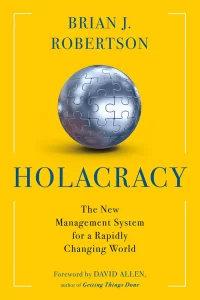Summary
Article 5 defines a distributed governance process at every level of the organization. It allows anyone in the company (not just the “managers”) to propose improvements to the organizational structure of roles and circles.
Adopting Modules 1 to 4 equates to implementing good management best practices. Module 5 fundamentally shifts the center of power to the governance process, thus making the organization truly “self-managed” and “purpose driven.”
Business value
- Decentralizes the governance process from the managers’ hands by allowing anyone to propose changes to the structure. Considerably increases the organization’s capacity to evolve to its environment, at a much faster pace, and empowers workers to address their own issues.
Key Features
Below is a summary of key elements from this module. For the actual rules, please see Constitution – Article 5.
Anyone Can Propose Changes
The governance process runs in every team at every level of the organization, not just at the “top.” Everyone in the team can participate to the team’s governance process and anyone can propose changes to the team’s structure of roles and policies using the Organizational Structure module.
Why it’s useful:
- Harvests the experience and ideas from everyone directly working in the team.
- Allows every team member to directly process their issues into meaningful change, without having to convince their overloaded team lead to do it for them.
- Relieves the team lead from having to solve everybody else’s issues; they can focus on the work they do best.
A Structured Process: Slow Is Smooth and Smooth Is Fast
Governance meetings are highly structured, which is often a surprise to new participants. While they leave little space for ‘open discussion’, the process is structured to encode healthy communication patterns (e.g. “seek first to understand, then to be understood”). It leads to a processing that is slower than what people are used to, but that also ineluctably drives to a resolution.
Why it’s useful:
- Everyone has a space to voice opinions and concerns, but no opinion or concern gets to dominate the space.
- Ineluctably drives to a resolution of the issue at hand.
- Prevents endless discussions, tangential conversations, topic hijacking, etc.
- Optional asynchronous process to adopt quick and easy changes.
A Unique “Objection” Process To Separate The Wheat From The Chaff
Perhaps the most challenging aspect of the governance process, yet the most powerful: it includes a step for participant to raise “Objections” to a proposed change, which require to be integrated before the change is approved.
The process has a mechanism to prevent Objections raised out of fear, ego-driven agendas, politicking, etc. Several conditions must be met for an Objection to be valid. The objector needs to articulate how…
- the proposed change would hurt the circle.
- the proposed change would limit one of their roles.
- the proposed change would create the issue (vs. merely failing to address an existing one).
- the objection is based on presently-known data, or if it isn’t, at least explain why it’s too risky to even try the proposed change.
This process prevents unfounded Objections to go through. When facilitated well, it also helps the objector refine and better articulate their objection.
Why it’s useful:
- Everyone has an opportunity to prevent bad ideas from being implemented.
- The process cuts through ego resistance and ungrounded fear of change. It keeps the discussion focused on what is best for the organization’s purpose.
- Slight bias toward experimentation.
An Evolutionary Process At Every Level
Enables a true “learning organization,” with true distributed authority—not as an aspirational claim but as a practical reality. This module allows the very structure of the organization to evolve and adapt at a much faster pace, but with less disruption than traditional reorganizations. It allows safe experimentation to iterate faster and learn.
Thanks to the decoupling of Roles and People in Module 1: Organizational Structure, frequent changes are much less disruptive.
Why it’s useful:
- Faster adaptation to market demand.
- Harvests more of people’s potential.
- Removes Circle Leads (or managers) as bottlenecks for needed structural changes.
- Smaller changes more often, instead of big reorganizations every 3 years.
Alternatives to Holacracy’s Governance Process
The common alternative to Holacracy’s governance process is to mimic the conventional hierarchical model:
Each Circle Lead has the authority to modify the governance of their circle at will.
You may choose to make some tweaks or clarify this fall-back process. For example:
- Does each Circle Lead have exclusive authority to modify their circle’s governance, or do the Circle Leads of broader circles also have authority to “intervene” in the sub-circles’ governance and modify it?
- Is there any requirement a Circle Lead needs to fulfill before modifying the governance, or is it left to each Circle Lead’s discretion? e.g. soliciting input from the team first.
Here is an example of an article you may add to your constitution instead of Module 5:
Each Circle Lead has the exclusive authority to modify the governance of their circle after proposing the change to all Circle Members and considering their feedback.
